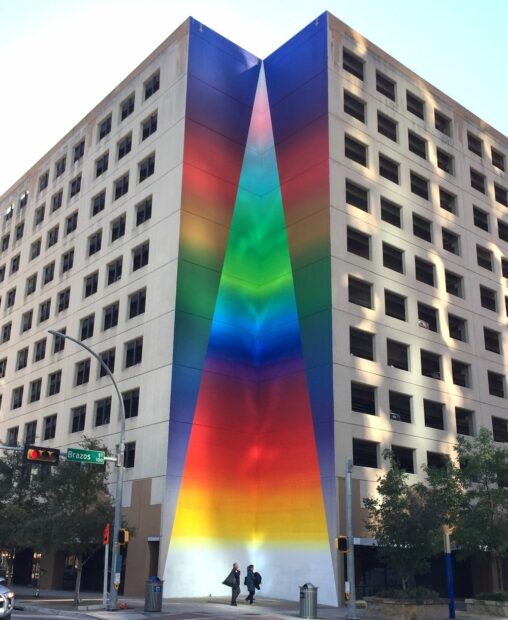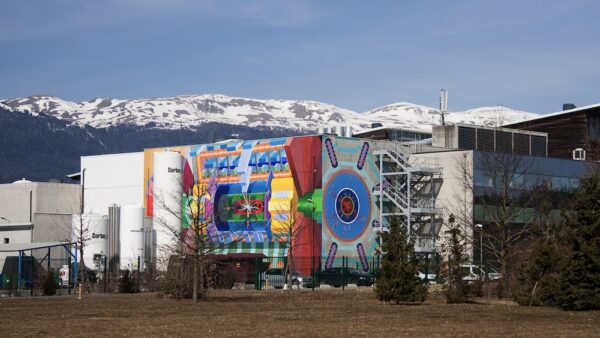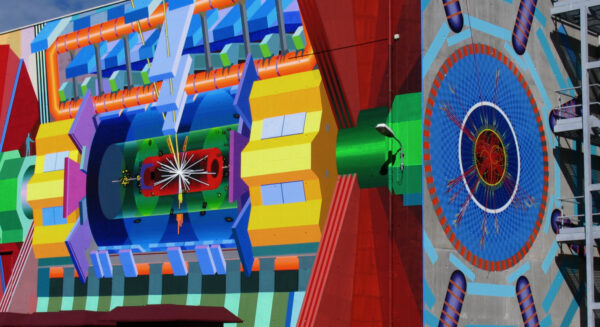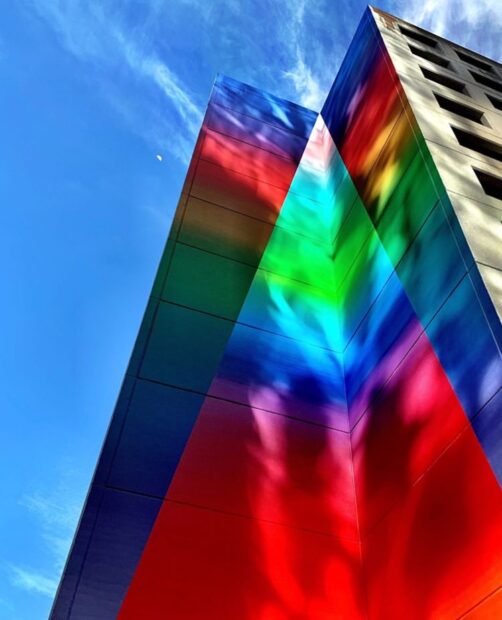Josef Kristofoletti was born in Nagyvarad, Transylvania. His work is primarily made up of mural paintings that address ideas about nature, technology, space, and architecture. He was an artist in residence at CERN, the European Organization for Nuclear Research in Switzerland.
As a founding member of the artist collective Transitantenna, he traveled throughout North America as part of a mobile living experiment that engaged local communities through public interventions. His work has appeared in several publications including Wired, PBS NewsHour, New York Times, The Guardian, Boston Globe, Fast Company, and Symmetry Magazine. In 2013 he represented the United States at the Bienal del Sur en Panama, in Panama City.
I met Kristofoletti in Austin while in architecture school. My background in studio art and my newly formed underpinnings in architecture drew me to his public art. His work immediately struck me as bold and powerful, derived from an understanding of place and structure in a way that I continue to find intriguing. His public works are playful, colorful and engaging in a way that inspire viewers to take a fresh look at their environment.
Garland Fielder: The public nature of your art practice seems consistent throughout the years. What led you to creating murals and outdoor installations as forms of expression rather than pursuing a more traditional studio practice? (Another way of thinking about this question is to ask, do you perceive collective experiences of your art differently than individual experiences of it? Do you preference one over the other?)
Josef Kristofoletti: Early on after I finished school and was imagining my life as an artist, it did come as a disappointment to me that my work as a painter could exist only to a limited number of collectors or people who go to art galleries. The idea that public art in a way is more democratic, and open to more people is important to me. I love and look at a lot of art, and also collect paintings, so the individual experience is one that I enjoy very much.
But for me, the motivation is much greater to make something that a lot of people are able to experience versus only a few. I remember seeing an arena concert once and thinking how powerful it is to have this collective experience of the music; I think, to me, working in the public has more of that energy. When I was living in a rural small town in high school I loved seeing the trains coming through town that were all painted with graffiti, and I love the idea that these trains are going all over the country. It’s a very democratic distribution system.
GF: How has your experience as an expat informed your work? Do you find that being an immigrant allows you to perceive your environment differently from natives? If so, how does this influence how you intend your art to be received?
JK: I think so. In Europe there is a different sense of social space that can be seen in the way cities are laid out. Let’s say, in an imagined world that I wanna live in, there’s a place in every neighborhood that people can go to hang out that has a garden and something interesting to look at — a sculpture, or some sort of public art, a kind of backdrop that communicates with our humanity. That seems to me is what I grew up with in Europe. It feels like in America neighborhoods are designed more based on the individual.
GF: When you create a site-specific work — like say, ATLAS detector, at the CERN institute, where your concept appears to be so intimately wrapped up in the program that the complex houses — do you rely mainly on instinct/inspiration, or is the end result largely a result of specific research into that venue?
JK: I do as much research as I can for any given project because I think it’s interesting to find all the possible angles of a public site, its history and surrounding, but then ultimately I decide to make something that feels inspired and not too didactic. Working at CERN was very unique; I wanted to work there because of what that physics research that they are doing means in our culture; it’s kind of the origin story of our time — trying to understand the Big Bang and other fundamental questions.
GF: In the work Tau Ceti Austin, 2018, where the end result appears much more abstract, are you drawing inspiration from colorists, like Itten or Albers, or are you responding more to the immediate environment? Do you find that there are certain combinations of aesthetic choices which can elicit determined responses in the viewer when the content is non-objective?
JK: The idea for Tau Ceti came from looking at how light reflects from nearby buildings at certain times of day onto that corner of the building. I also thought it was kind of a fun challenge to see if I could paint a color gradient that was over a hundred feet long and how would that look among the surrounding buildings.
I am very interested in color. It feels like the more I try and understand color the more interesting it gets. I like that color can have such an effect on us. I worked as a house painter for many years and I always loved how a room can feel so different with a different coat of paint. The painting Tau Ceti is a big triangle, so that has a certain effect on people — it’s the shape of a steeple or the great pyramids. I want the painting and the building to have a conversation, and it makes sense for me to work in a abstract way so that they are both speaking the same language.
GF: 2020 has been a unique and challenging year for us all. How have the events of late affected your thinking about your art? The rich history of the genre as seen through the lens of Diego Rivera or Juan O’Gorman, for instance, would seem ripe for new interpretations today. Do you find that your art, or artwork in general, should have a social charge? If so, has that changed in recent times?
JK: The pandemic has forced most museums and galleries to close to the public or forced them online; in that respect public art has received a new spotlight because people could still go see it. I think painting has a very limited impact for social change compared to actual laws and legislation, but it is just as potent as ever for sending a message — like when people painted “BLACK LIVES MATTER” in front of the White House.
For me the challenge of doing public work is to find a way to make something that has a universal element. Socially charged public work can bring people together, or it also can be divisive. Various murals with more overt social messages are sometimes targeted and get defaced or tagged because people see them as a place of social critique. I think that a mural can bring an aspect of humanity to a building that it might otherwise lack, but at the same time I’m weary of when murals are used as merely a gentrification tool. Painting slogans on the street is definitely a sign of a powerful form of art and protest that is important. As for the sculptures of generals that have been toppled in the last year, I hope they can be replaced with something more interesting.
GF: The dialogue between your murals and the structures they exist upon seems very planned and conscious. Can you explain how you come to decide upon the aesthetic choices you make with regard to each artwork’s environment? If you had to proport a ratio of influence, how much would architecture determine the mix, as opposed to other considerations?
JK: Architecture is always the jumping off point for me. I think about what can the painting do with the building, and vice versa. I would ultimately love a situation or opportunity where I could collaborate with architects from the beginning of their design process so that the mural is integrated in a way that would maximize the potential of the artform. Applying a mural to an already existing building sometimes feels like you are just putting a sticker or a tattoo on it.
I still feel like a lot of architects wanna design just white or beige buildings, or maybe that is dictated by the market. The more interesting the building is architecturally, the more there is an opportunity for a mural to have a meaningful interaction with it. Both painting and architecture deal with space in a similar way to some degree, so I think those things can be brought together in new ways we’ve never seen before.
Find more on Josef Kristofoletti here. This interview has been lightly edited for length and clarity.







